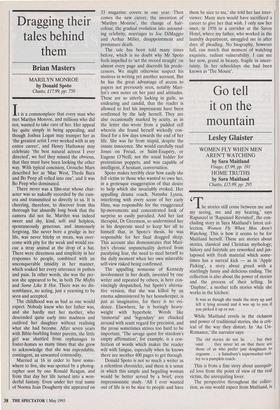Go tell it on the mountain
Lesley Glaister
WOMEN FLY WHEN MEN AREN'T WATCHING by Sara Maitland Virago, 15.99, pp. 191 HOME TRUTHS by Sara Maitland Chatto, £15.99, pp. 295 The stories still come between me and my seeing, me and my hearing,' says Rapunzel in `Rapunzel Revisited', the con- cluding story in Sara Maitland's latest col- lection, Women Fly When Men Aren't Watching. This is how it seems to be for Maitland herself. These are stories about stories, classical and Christian mythology; history and fairytale are reworked and jux- taposed with fresh material which some- times has a surreal kick — as in 'Apple Picking', a story about greed with a startlingly funny and delicious ending. The collection is also about the power of stories and the process of their telling. In `Daphne', a mother tells stories while she works in the kitchen: It was as though she made the story up and left it lying around and it was up to you if you picked it up or not.
While Maitland revels in the richness and power of traditional stories, she is crit- ical of the way they distort. In 'An Un- Romance,' the narrator says:
The old stories do not lie . . . but they omit . . . they never let on that there are those of us who prefer jam doughnuts to orgasms . . . a Sainsbury's supermarket trol- ley to a pumpkin coach.
This is from a fine story about unrequit- ed love from the point of view of the real victim, the unrequiting lover.
The perspective throughout the collec- tion, as one would expect from Maitland, is uniformly feminist. A great deal of debunk- ing goes on as old characters are sum- moned back to life and given contemporary voices that give fresh life to the old tales. Rapunzel suffers from osteoporosis of the neck — well, who wouldn't if a prince had climbed 20 foot up her golden hair?
Perhaps the most powerful presence in Maitland's novel Home Truths is a piece of electronic wizardry — a prosthetic hand. It is monster to central character Clare's Frankenstein — not fully within her control. It shatters glass by squeezing too hard, crushes the wrist of her deaf niece Alice, and strikes Clare's mother on the face. It is malevolent, a squatting crab-like thing, a haunting creation.
Clare is landed with this gadget after an accident which begets the novel's central mystery. While on holiday in Zimbabwe, Clare and her lover, David, set out to climb Mount Nyangani. Six days later, Clare is found wandering and confused and with a severely injured right hand — later to be amputated. David is never found. As well as her lover and her hand, Clare has also lost her memory about what happened. Several explanations for David's disappear- ance are offered: political — Mount Nyan- gani is a haunt of RENAMO guerillas; natural — there are treacherous mists and crevices; and mythological — the mountain spirits are hostile to white tourists. More sinister for Clare than any of these expla- nations is the possibility that she killed him herself. Her rescuers claim that she con- fessed to his murder after her rescue later she simply cannot remember. All she does remember is that at times she did wish him dead. She is afraid that she did murder him and throughout the novel she and her multitudinous family are concerned to work their way through her post-traumatic amnesia and discover the truth.
Clare, her seven siblings and their fami- lies are summoned by their high Church aristocratic parents to Sutherland for a summer break. The children, with varying degrees of reluctance, all turn up, which makes at first for a confusingly large cast of characters. Two scandals have rocked this respectable and respected family's founda- tions — the inexplicable disappearance of David, and the tabloid shame of Clare's brother Ben, a clergyman who has been exposed as a practising homosexual, with a nipple ring to boot.
The main action of the novel takes place over six days of this family holiday, but the time scheme is complex; it opens like a concertina to reveal memory within some- times contradictory memory. The family atmosphere, the teasing and anger, the old jokes, the irritable, resentful love are con- vincingly and compellingly portrayed, as is the off-hand dialogue. There is, though, a plethora of exposition when the omniscient narrator adopts a particularly bossy tone and spells out things which could as easily be made apparent through action and dia- logue, and at certain points this is not only irritating but threatens to hamper the nar- rative flow.
The novel has a strong premise and a convincing cast of characters but it is pud- ding stuffed too full of plums. There is an overload of heavily significant themes time, chaos, feminism and post-feminism, homoeroticism and the clergy, science ver- sus mythology, and disability, to mention but a few. The symbols in the book are very heavily underlined and overworked. But it is a novel of fine intelligence, and the writ- ing is often — particularly in the nature descriptions and the evocation of the supernatural — very beautiful. Despite its over-richness, it does work. It becomes less unwieldy towards its close, the pace picks up as exposition and theorising are shed and there is a fine, almost thrillerish ele- ment of tension as the subtle and unexpect- ed part-resolution of the mystery• is approached.



























































 Previous page
Previous page